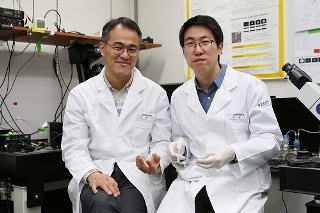Apr 9 2018
A research team from KAIST has devised a highly personalizable neural stimulation technique. The researchers have developed a technology that can be used to print the heat pattern on a micron scale to allow the remote control of biological activities.
 Professor Nam and Dr. Kang, right. (Image credit: KAIST)
Professor Nam and Dr. Kang, right. (Image credit: KAIST)
The team combined a precision inkjet printing technology with bio-functional thermo-plasmonic nanoparticles to create a “selective nano-photothermal neural stimulation method.”
The team of Professor Yoonkey Nam from the Department of Bio and Brain Engineering anticipates that this will function as an enabling technology for customized precision neuromodulation therapy for patients suffering from neurological disorders.
As part of the nano-photothermal neural stimulation technique, the thermo-plasmonic effect of metal nanoparticles is used to control the activities of neuronal networks. Using the thermo-plasmonic effect, the metal nanoparticles can absorb a particular wavelength of illuminated light to effectively produce localized heat. Four years ago, the researchers found out the inhibitory nature of spontaneous activities of neurons following photothermal stimulation. From that time, they have advanced this technology to modulate hyperactive behaviors of neural circuits and neurons, which is usually the case in neurological disorders such as epilepsy.
To overcome the restriction on the resolution and spatial selectivity of the already devised nano-photothermal technique, the researchers used an inkjet printing technique to micro-pattern the plasmonic nanoparticles (a few tens of microns) and successfully showed that the nano-photothermal stimulation can be selectively employed based on the printed patterns.
The team employed a polyelectrolyte layer-by-layer coating technique to print substrates in a manner to enhance the pattern fidelity and accomplish uniform assembly of nanoparticles. The electrostatic attraction between the coated printing substrate and the printed nanoparticles also improved the stability of the attached nanoparticles. Since the polyelectrolyte coating is biocompatible, biological experiments including cell culture can be carried out by using the technique developed in this study.
The researchers used printed gold nanorod particles with a resolution of few tens of microns over an area of several centimeters and demonstrated that highly complex heat patterns can be accurately formed through light illumination based on the printing image.
Finally, the researchers established that the printed heat patterns have the ability to selectively and promptly obstruct the activities of cultured hippocampal neurons through near-infrared light illumination. Since the printing process can be applied to flexible and thin substrates, the technique can be easily used for implantable neurological disorder treatment devices and wearable devices. The selective application of the heat patterns to only the desired cellular areas enables providing personalized and customized photothermal neuromodulation therapy for patients.
The fact that any desired heat patterns can be simply ‘printed’ anywhere broadens the applicability of this technology in many engineering fields. In bioengineering, it can be applied to neural interfaces using light and heat to modulate physiological functions. As another engineering application, for example, printed heat patterns can be used as a new concept of anti-counterfeit applications.
Yoonkey Nam from KAIST, Principal Investigator
This study, mainly headed by Dr. Hongki Kang, was reported in ACS Nano journal on February 5, 2018.